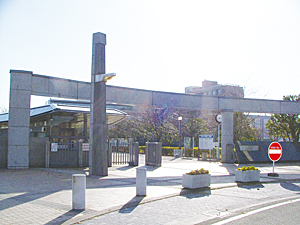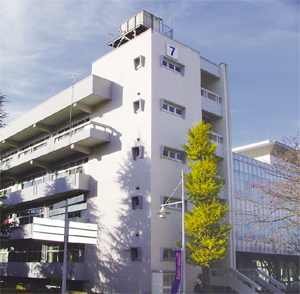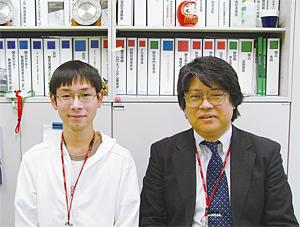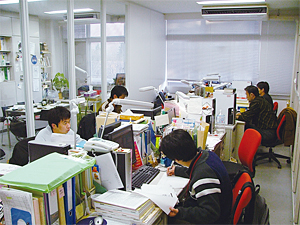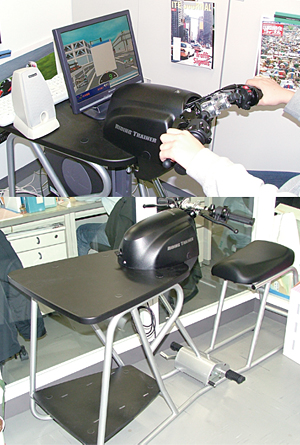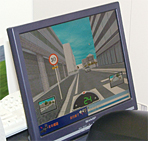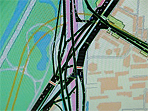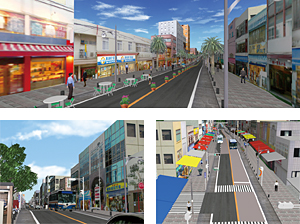Concept of Utilizing IT Is "Having Unique Technology" and "Serving the Society" --
Introduction of "UC-win/Road" into the Social Experiments in Okinawa is a Part of It
The Lab. uses Forum8's "UC-win/Road" as a tool to visualize, compare, and examine individual policies in social experiments of introducing a transit mall for revitalization of the urban center of Naha city, Okinawa Prefecture. Based on the data produced in the above process, the Lab submit a work entitled "VR Simulation for Comparing Landscape of the Transit Mall on Kokusai Street ", to the 5th Contest for 3D-VR Simulation sponsored by Forum8 Co. Ltd. held on November 27, 2006. They got the "Essence Prize," a newly established prize to honor a small-scaled but outstanding work. We interviewed Mr. Atsushi Fukuda, Professor at the Lab, and Mr. Shunta Shimizu, Senior of Science & Technology, who took charge of the above simulation.
The origin of College of Science & Technology, Nihon University dates back to 1920, when Technical Higher School (Koto Kogakko) of Nihon University was founded. Later, the school was extended to be College of Technology in 1928, which was renamed as College of Science & Technology in 1958.
It was 1961 when Department of Transportation Engineering, the predecessor of Dept. of Transportation Engineering & Socio-Technology was established within College of Science and Technology. This was to meet the request of early training of transportation engineers for construction of the Tomei (Tokyo-Nagoya) Expressway and Meishin (Nagoya-Kobe) Expressway at that time. In response to the changing needs of the times, the department was renamed as Transportation Civil Engineering (1979), and Transportation Engineering & Socio-Technology (2001) as is now.
Department of Transportation Engineering & Socio-Technology is very unique in that it is the only department to specialize in transportation among civil engineering-related departments in Japan. The makeup of the scholars is characterized not only by well-stocked specialists of planning but also a wide range of important fields relating to transportation, including landscape, design, and civil engineering.
Aiming at "analysis of transportation system" by means of "system-technological approach," Professor Atsushi Fukuda established Transportation System Lab, the name of which reflects his passion. In the Lab, various mathematical planning methods and simulation models have been developed. The Lab's goal is to produce specific results by applying those methods and models in considering transportation policies and projects designed for developing countries, which are facing serious traffic problems.
Before establishing the Lab, Prof. Fukuda was sent to Asian Institute of Technology as a specialist for a project of JICA (Japan International Cooperation Agency) and to teach there. With this experience, his researches have been focused on Southeast Asia as a main target area, covering the whole field of transportation.
The social experiments of transit mall in Okinawa, which was taken up in the work that got the prize in the above contest, is one of the exceptional matters for "Transportation System Lab (Fukuda Lab)," as the Lab declares that it focuses on Asia as much as possible. "In my criteria, Okinawa is an Asian city," Prof. Fukuda says, and this remark discloses the attitude of the lab.
"We had had no connection with Okinawa," he says, "until about 6 years ago when a city hall official of Naha called on us unexpectedly, who was in charge of drawing a basic plan according to the nation's basic policy based on 'The Act for City Center Revitalization'." Recommended by the academic society member and traveling all the way, the official visited the lab to ask cooperation. Then the professor visited Okinawa in return with his students to tell his intention to study jointly with them, and was welcomed greatly. Later, they worked together to prepare a proposal. Taking this opportunity and with cheerful personalities of the local people concerned, they got to know each other better.
Their plan was adopted as a target for social experiments sponsored by Road Bureau, Ministry of Land, Infrastructure, and Transport, and it was decided to materialize the experiments to introduce a transit mall on Kokusai Street. Taking this opportunity, Professor Fukuda was requested by the local committee for the transit mall introduction on the experiment to perform his duty as a deputy chief of the representative group of the committee.
Kokusai Street, where the experiments take place, has developed as a city center of Naha. On the other hand, the number of shops has been decreasing since 1980's due to the influence of setting up of large-scale, suburban type commercial establishments and others. The revitalization of Kokusai Street, therefore, has been a big challenge for the region.
For this reason, new measure of revitalization was sought, and the effect of introducing a transit mall in experiment was the center of everyone's hopes. A transit mall is so made as to restrict general vehicles in the main streets of the urban center and so on, as well as to create bustle by opening the road to pedestrians, cyclists, or public transportation. As Kokusai Street is about 1.6km (1 mile) long, the social experiment is called by its nickname of "Transit Mile." With the first experiment performed in 2002, 4 series of introductive experiments have been implemented over 4 years.
At every experiment, the Lab held a study meeting with the local people concerned, where the lab tried to make up new suggestions based on various analyses.
For example, in the social experiments, a bus route within a transit mall is arranged according to the theme of each experiment seeking for the best running lane. For the first one, safety cones and cone bars were placed with a running lane between them set at the center of the roadway, so as to secure a running lane. For the second experiment, the number of safety cones was minimized in order to take landscape into consideration, and planters were placed instead. For the third one, while safety cones replaced planters again, they reduced the number of the cones by half by moving the running lane to one side.
Besides, as it would be impossible to load and unload commodities and other goods on Kokusai Street, measures to secure parking facilities for loading and unloading were considered. Also, unification of color of the awnings, which were installed as a part of the renovation project continued since 1999, were examined and proposed.
In the above process, VR (virtual reality) data have been produced with "UC-win/Road" based on the video images of present conditions shot on the spot of the social experiments. These data have been utilized for prior explanation to the parties concerned or for preparing the proposals thereafter.
From February to March 2007, a social experiment is scheduled conduct only on every Sunday as a project of Ministry of Economy, Trade, and Industry, for which preparation is going on.
"I have a sense of crisis in that discussion and evaluation in the field of transportation are limited on IT (information technology) and ITS (intelligent transport system) in Japanese Universities in these 5-6 years, resulting in lacking of practical technology," Prof. Fukuda says.
He continues that in America, the university where he visited had been performing experiments of ITS using their own system as a matter of course, and that he was shocked to realize the difference of between US and Japan in the way of working. That experience made his motto more robust; that is, "as transportation is something which deals with human lives in itself, its study should be done on the spot, and not by book learning, to actually serve in the world." Approaches to concretize this should be based on a viewpoint of "having unique technology," which led the Lab to use several tools including "UC-win/Road" freely, and to place greater weight on the simulation of transportation and its analysis, he points out.
In big cities of Southeast Asia, motorcycles have been positioned as a main means of transportation without a parallel in the world. However, the truth is that the designs of traffic facilities such as traffic signals and road structures do not seem to take motorcycles into consideration. As a result, the number of fatal accidents caused by motorcycles has reached the level that can' t be overlooked. Then, in considering traffic safety measures suited for the actual location, Prof. Fukuda is paying attention to use of a riding simulator for motorcycle.
It is necessary to largely modify as well as localize the data and functions to do this; it can't be done easily, though. For this reason, he went on to consider if he could realize practical application effectively, for example, by linking with "UC-win/Road."
"To tell the truth, I was startled to hear the speech of Mr. Tadaharu Wada, Chairman of Forum8 at "3D-VR Simulation Contest," he says.
Mr. Wada said that "UC-win/Road" should not be a mere tool to show realistic images, but be designed for its functions to become able to draw solutions of many different transport problems such as improvement of traffic-accident prone areas, which scholars should seek as their primary goal. His way of thinking was coincident with the direction that Prof. Fukuda did have conceived.
"By using 'UC-win/Road,' we would like to examine the present problems of transportations in Asia, and suggest a proposal of improving an intersection, for example."
We are most grateful to those who took up their time for the interview
<Related Information>
